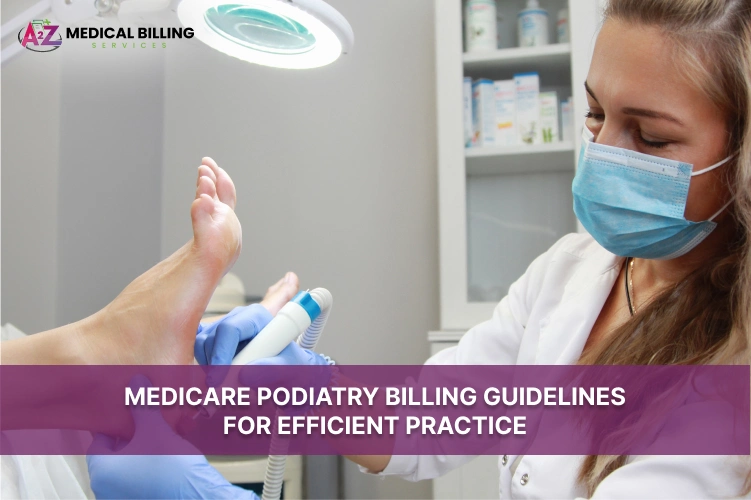Medicare Podiatry Billing Guidelines are essential for healthcare providers, especially podiatrists, to understand thoroughly. Mistakes in billing can lead to claim denials or delays, affecting practice revenue and patient care.
These guidelines outline which podiatry services are covered by Medicare, specifying which treatments are reimbursable. Comprehending these guidelines is crucial for accurate billing, as they detail the necessary documentation to support claims.
It assists healthcare providers in improving their billing practices, maintaining compliance, and ensuring efficient operations within Medicare’s regulations.
Covered Podiatry Services Under Medicare
This section Identifies, which podiatry services are reimbursable by Medicare and the conditions under which these services qualify.
Medically Necessary Services
Medicare defines medically necessary services as those required to diagnose or treat an illness, injury, condition, disease, or its symptoms. In podiatry, this includes treatments for conditions that significantly impair mobility or lead to severe dysfunction of the feet. Key examples include:
- Diabetic Neuropathy: Comprehensive foot exams and treatment are covered due to the high risk of foot ulcers and infections in diabetic patients.
- Peripheral Arterial Disease (PAD): Treatment for PAD may involve services to address foot pain and mobility issues that directly result from this condition.
Exclusions and Special Circumstances
Medicare typically excludes coverage for what it regards as routine foot care. However, exceptions exist for patients with systemic conditions that create significant foot health risks. Examples of excluded services and their exceptions include:
- Routine Nail Care: Only covered if the patient has a systemic condition like diabetes that causes poor circulation, increasing the risk of nail infections and foot ulcers.
- Callus Removal: Covered when excessive calluses lead to or worsen ulcers, the patient has a diagnosed condition like diabetes that complicates their foot health.
Documentation and Compliance for Billing
The essential documentation required to comply with Medicare guidelines and ensure that claims are successful.
Required Documentation for Reimbursement
For Medicare to reimburse podiatry services, precise documentation is crucial. The following documents must be carefully maintained to support claims:
- Patient Medical Records: Must include detailed notes from every visit, outlining the diagnosis, treatment plan, and progress notes.
- Treatment Authorization: Documentation showing that the treatment provided was authorized, especially for services that might typically be considered routine but were necessary due to specific medical conditions.
- Proof of Medical Necessity: Clear evidence that the services provided were necessary for the treatment or management, it is a condition recognized by Medicare.
Common Billing Errors and How to Avoid Them
Billing errors can lead to delayed or denied claims. Understanding common mistakes can help ensure that claims are processed efficiently:
- Incorrect Coding: Always use the most current ICD-10 and CPT codes. Double-check codes for accuracy before submission.
- Incomplete Documentation: Ensure that all required documentation is complete and available for billing. Missing information is a common reason for claim denial.
- Failure to Verify Insurance: Regularly verify Medicare coverage before services are provided to confirm that the patient’s plan covers the proposed treatments.
UseingTechnology for Efficient Billing
Explore how advanced billing software and tools can enhance the Medicare billing process for podiatry services, making it more efficient and compliant.
Recommended Software Solutions
Modern medical billing software is important in enhancing the efficiency and accuracy of Medicare claims processing for podiatry. Key features to look for in top-rated medical billing software include:
- Integration with Medicare’s Systems: Ensures smooth data transfer and compliance with Medicare’s latest regulations.
- Real-Time Eligibility Verification: Automatically verifies patient coverage to prevent billing issues.
- Advanced Coding Tools: Helps in selecting the correct codes to reduce denials due to coding errors.
Advantages of Automated Billing Systems
Automated billing systems in podiatry practices by streamlining administrative tasks and reducing human error. The advantages include:
- Reduced Billing Errors: Automated systems minimize human errors in data entry and code selection, leading to fewer claim rejections.
- Faster Claim Processing: Automation speeds up the claim submission process, leading to quicker reimbursements.
- Improved Documentation Management: These systems help organize and store patient records and billing information securely, making it easy to recover and update information as needed.
Staying Updated with Medicare Changes
Learn why it’s crucial to stay informed about Medicare updates and their direct impact on podiatry billing practices.
Resources for Medicare Updates
Keeping level of the latest changes in Medicare regulations is important for compliance and efficient billing. Podiatrists and billing specialists can access up-to-date information through several key resources:
- CMS Official Website: Regular updates on new billing guidelines and regulations.
Medicare Administrative Contractors (MACs): MACs provide region-specific guidance that is crucial for localized practice standards.
- Professional Associations: Organizations like the American Podiatric Medical Association (APMA) offer resources tailored to podiatrists, including updates on Medicare changes.
Training and Continuing Education
Continuous education is essential for maintaining expertise in Medicare billing practices. Engaging in ongoing training can significantly enhance billing accuracy and compliance:
- Online Courses and Webinars: Many organizations offer courses designed to keep healthcare providers current with changes in Medicare policies.
- Workshops and Conferences: These events provide valuable networking opportunities and insights from industry leaders and peers.
- Certification Programs: Advanced certification in medical billing can refine a specialist’s skills and knowledge, keeping them ahead in their field.
Conclusion
This guide has provided a detailed overview of Medicare Podiatry Billing Guidelines, aimed at clarifying coverage, documentation requirements, and technological tools that enhance efficient billing practices. By understanding and applying this information, healthcare providers can meet Medicare’s standards, avoid common billing errors, and improve operational effectiveness. Staying informed through continuous education and using advanced billing solutions are essential for compliance and securing timely reimbursements.
FAQs
1. What podiatry services does Medicare cover?
Medicare covers podiatry services that are medically necessary, such as treatments for diabetic neuropathy and peripheral arterial disease.
2. Does Medicare cover routine foot care services?
Routine foot care is typically not covered unless linked with systemic conditions like diabetes, which significantly affect foot health.
3. What documentation is required for Medicare podiatry billing?
Required documentation includes detailed medical records, treatment authorization, and proof of medical necessity.
4. How can billing errors be avoided in Medicare podiatry claims?
Ensure accurate coding, complete documentation, and verify patient insurance coverage to avoid common billing errors.
5. Where can podiatrists find updates on Medicare billing guidelines?
Updates can be accessed through the CMS official website, Medicare Learning Network, and relevant professional associations like the APMA.



